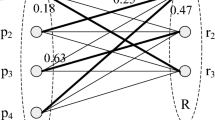Abstract
In the process of reviewing and ranking projects by a group of reviewers, the allocation of the subset of projects to each reviewer has major impact on the robustness of the outcome ranking. We address here this problem where each reviewer is assigned, out of the list of all projects, a subset of up to k projects. Each individual reviewer then ranks and compares all pairs of k projects. The k-allocation problem is to determine an allocation of up to k projects to each reviewer, that lie within the expertise set of the reviewer, so that the resulting union of reviewed projects has certain desirable properties. The k-complete problem is a k-allocation with the property that all pairs of projects have been compared by at least one reviewer. A k-complete allocation is desirable as otherwise there may be projects that were not compared by any reviewer, leading to possible adverse properties in the outcome ranking. When a k-complete allocation cannot be achieved, one might settle for other properties. One basic requirement is that each pair of projects is comparable via a ranking path which is a sequence of pairwise rankings of projects implying a comparison of all pairs on the path. A k-allocation with a ranking path between each pair is the connectivity-k-aloc. Since the robustness of relative comparisons deteriorates with increased length of the ranking path, another goal is that between each pair of projects there will be at least one ranking path that has at most two hops or q hops for fixed values of q. An alternative means for increasing the robustness of the ranking is to use a k-allocation with at least p disjoint ranking paths between each pair. We model all these problems as graph problems. We demonstrate that the connectivity-k-aloc problem is polynomially solvable, using matroid intersection; we prove that the k-complete problem is NP-hard unless k = 2; and we provide approximation algorithms for a related optimization problem. All other variants are shown to be NP-complete for all values of k ≥ 2.
Similar content being viewed by others
References
Ageev A.A., Sviridenko M.I.: Pipage rounding: a new method of constructing algorithms with proven performance guarantee. J. Comb. Optim. 8, 307–328 (2004)
Asahiro Y., Iwama K., Tamaki H., Tokuyama T.: Greedily finding a dense subgraph. J. Algorithms 34, 203–221 (2000)
Bartholdi J.J., Tovey C.A., Trick M.A.: The computational difficulty of manipulating an election. Soc. Choice Welfare 6, 227–241 (1989)
Brans J.P., Vincke P.H.: A preference ranking organization method. Manage. Sci. 31, 647–656 (1985)
Brezovec C., Cornuejols G., Glover F.: Two algorithms for weighted matroid intersection. Math. Programming 36, 39–53 (1986)
Brezovec C., Cornuejols G., Glover F.: A matroid algorithm and its application to the efficient solution of two optimization problems on graphs. Math. Programming 42, 471–487 (1988)
Chekuri, C., Kumar, A.: Maximum coverage problem with group budget constraints and applications. In: Proceedings of APPROX 2004, pp. 72–83 (2004)
Cook W.D., Golany B., Kress M., Penn M., Raviv T.: Optimal allocation of proposals to reviewers to facilitate effective ranking. Manage. Sci. 51, 655–661 (2005)
Dor D., Tarsi M.: Graph decomposition is NP-complete: a complete proof of Holyer’s conjecture. SIAM J. Comput. 26, 1166–1187 (1997)
Eswaran K.P., Tarjan R.E.: Augmentation problems. SIAM J. Comput. 5, 653–665 (1976)
Feige U., Kortsarz G., Peleg D.: The dense k-subgraph problem. Algorithmica 29, 410–421 (2001)
Fernandez E., Olemdo R.: An agent model based on ideas of concordance and discordance for group ranking problems. Decis. Support Syst. 39, 429–443 (2005)
Frederickson G.N., Srinivas M.A.: Algorithms and data structures for an expanded family of matroid intersection problems. SIAM J. Comput. 18, 112–138 (1989)
Fuller R., Carlsson C.H.: Fuzzy multiple criteria decision making: recent developments. Fuzzy sets syst. 78, 139–153 (1996)
Gabow, H.N., Tarjan, R.E.: Almost optimum speed-ups of algorithms for bipartite matching and related problems. In: Proceedings of STOC 1988, pp. 514–527 (1988)
Gabow H.N., Tarjan R.E.: Faster scaling algorithms for network problems. SIAM J. Comput. 18, 1013–1036 (1989)
Garey M.R., Johnson D.S.: Computers and Intractability. W.H. Freeman, New York (1979)
Hochbaum, D.S., Chandran, B.: Further Below the Flow Decomposition Barrier of Maximum Flow for Bipartite Matching and Maximum Closure. Manuscript, UC Berkeley, April (2004)
Hochbaum D.S., Levin A.: Methodologies for the group rankings decision. Manage. Sci. 52, 1394–1408 (2006)
Holyer I.: The NP-completeness of some edge-partition problems. SIAM J. Comput. 10, 713–717 (1981)
Hsu T., Ramachandran V.: On finding smallest augmentation to biconnect a graph. SIAM J. Comput. 22, 889–912 (1993)
Keener J.P.: The perron-frobenius theorem and the rating of football teams. SIAM Rev. 35, 80–93 (1993)
Kemeny, J.G., Snell, J.L.: Preference ranking: an axiomatic approach. In: Mathematical Models in the Social Sciences, Ginn, Boston, pp. 9–23 (1962)
Park, J., Newman, M.E.J.: A network-based ranking system for US college football. J. Stat. Mech.: Theory Exp. (Oct. 31, 2005). Abstract available at http://www.iop.org/EJ/abstract/1742-5468/2005/10/P10014
Rosenthal A., Goldner A.: Smallest augmentations to biconnect a graph. SIAM J. Comput. 6, 55–66 (1977)
Schrijver A.: Combinatorial Optimization Polyhedra and Efficiency. Springer, Berlin (2003)
Author information
Authors and Affiliations
Corresponding author
Additional information
An extended abstract version of this paper appeared with the title “The k-allocation problem and its variants” in Proceedings of the Fourth Workshop on Approximation and Online Algorithms (WAOA 2006).
Dorit S. Hochbaum—Research supported in part by NSF award No. DMI-0620677 and CBET-0736232.
Rights and permissions
About this article
Cite this article
Hochbaum, D.S., Levin, A. How to allocate review tasks for robust ranking. Acta Informatica 47, 325–345 (2010). https://doi.org/10.1007/s00236-010-0120-9
Received:
Accepted:
Published:
Issue Date:
DOI: https://doi.org/10.1007/s00236-010-0120-9




